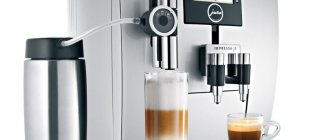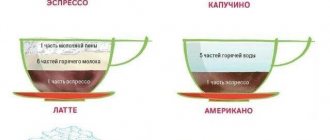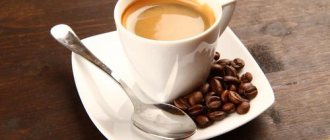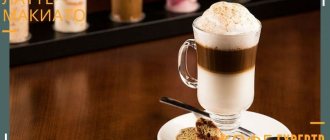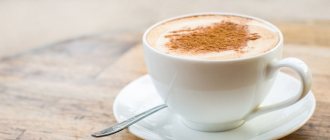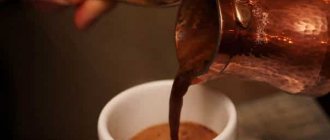What is the right time to drink cappuccino?
People in Italy drink cappuccino only in the first half of the day, believing that full-fat milk after lunch is harmful to proper nutrition and spoils the figure. Typically, pasticcerias do not serve it after lunch.
In the evening, it is customary to drink varieties of black coffee without sugar, but with substitutes. But they make an exception for tourists. In other countries, afternoon cappuccino is tolerated.
In America, they don’t even care what time to drink cappuccino.
But let's go back to basics and continue exploring Italian tastes.
Also, Italians never drink cappuccino with a large meal. It is believed that milk is a food that is consumed separately. You can eat something starchy with a cup of cappuccino, but never wash it down with your main meal.
Italians are very careful about their health and do not allow themselves to overload their stomach. In big cities they are already accustomed to the fact that tourists can drink cappuccino at any time of the day or night, but in small towns you will be persistently asked to think before drinking a cup of such coffee. And believe me, they will do this, taking care of your well-being.
How to choose milk for cappuccino?
How to choose milk for cappuccino? This is a very important question, because, according to professional baristas, there are no trifles in such a serious matter as making coffee. Judge for yourself. What is cappuccino? In the understanding of Italian gourmets, cappuccino is a coffee drink, the main ingredients of which are milk and lush milk foam. In other words, a good cappuccino is, first of all, good milk!There is a lot of debate among professionals about which milk is best for cappuccino. Some argue that milk for cappuccino must be very fatty, while others generally whip exclusively cream. As often happens, there is no clear answer to the question of which milk is best for cappuccino. The tastes and preferences of gourmets play a significant role in this matter, but there are still some recommendations.
Frothing milk for cappuccino is a responsible task. Moreover, even if you correctly reproduce all the actions associated with this process, a 100% positive result is not guaranteed. After all, the quality of the foam directly depends on some characteristics of the milk, namely its fat content, the amount of proteins and temperature.
Fat content of milk for cappuccino
Why does the fat content of milk for cappuccino affect the nature of the resulting foam? The fact is that the amount of fat changes not only the taste, but also the texture of the liquid. Most often, bars and coffee shops use milk with a fat content of 3.5%. This milk is considered, let's say, the golden mean - it is not too fatty, but not too watery and allows you to achieve the ideal balance of coffee taste and texture.
However, milk with a reduced fat content (for example, 1-2%) is not very different in taste and texture from 3.5%, but upon careful comparison it still seems somehow watery and fragile. In such a matter as frothing milk for cappuccino, you should not go to extremes. That is, you don’t need to think that the fattier the drink, the better the foam.
Sometimes it happens that a barista, in order to save money, mixes skim and 3.5 percent milk, which is not the right decision. However, a picky gourmet may not notice the difference.
As for skim milk, the lack of fat in the composition makes it a little sweeter than usual. Accordingly, this drink has a different texture. Skim milk produces a rather dense and dry foam, which when added to coffee turns it gray. This foam does not add density or a more pronounced structure to the coffee. In short, if you want to enjoy a truly aromatic, rich coffee drink, then remember that the fat content of milk for cappuccino should be about 3-3.5%.
Natural protein content
Often, novice coffee lovers, when choosing milk for cappuccino, do not pay due attention to such a point as the natural protein content in the product. But in vain! In the formation of foam of the required thickness, it is not fat content that plays a big role, as many believe, but protein. If the protein level in the product you choose is 2% or higher, then rest assured that the result will meet all your expectations.
It is important to remember that you should choose only natural milk for cappuccino, and in no case should it contain powder components.
Milk temperature for cappuccino
According to the rules for preparing a high-quality coffee drink, the temperature of milk for cappuccino should be +4 degrees Celsius. It is important that before whipping the milk is not boiled, that is, denatured. Moreover, directly during the preparation of foam, you should strictly ensure that the temperature of the milk does not exceed +67 - +75 degrees Celsius, otherwise the process of destruction of protein compounds will begin. As a result, you will not get good foam, and the milk itself will acquire a bitter taste and an unpleasant odor.
If you decide to master the art of frothing milk for cappuccino, then take note: the pitcher (or any other container in which frothing will take place) must be dry. The fact is that water or condensation getting into the milk will worsen the foaming process. Another rule to follow is that all utensils that come into contact with the cappuccino, including coffee cups, must be preheated to 40 degrees.
So, in light of all the recommendations described above, frothing milk for cappuccino may not seem like a tricky business at all. However, success in this case can be achieved only through experiments and experiments. And it doesn’t matter if you use up more than one carton of milk before you get the perfect foam. A real cappuccino is really worth it!
Table of milk for cappuccino
The recommended table with the characteristics of various brands of milk will help all site visitors choose the most suitable product for making high-quality cappuccino. We bring to your attention the most popular brands of dairy products presented on the domestic market.
The most popular products in the category - Coffee beans
Lavazza coffee beans Qualita Oro 1 kg 1382 rub.
| Paulig Arabica coffee beans 1 kg 676 rub. | Santo Domingo coffee beans Puro Cafe 454 g 900 rub. | Hausbrandt Espresso coffee beans 1 kg 2085 rub. | Goppion Caffe coffee beans JBM 1 kg 3265 rub. |
| Diemme coffee beans Miscela Excellent 1 kg 3504 rub. |
The most popular products in the category - Ground coffee
| Lavazza ground coffee Oro 250 g 377 rub. | Paulig Espresso Originale ground coffee 250 g 150 rub. | Dallmayr ground coffee Prodomo 250 g 350 rub. | Ground coffee Me Trang Arabica 250 g 404 rub. | Hausbrandt ground coffee Espresso 250 g 681 rub. |
| Goppion Caffe ground coffee JBM (JaBlMo) 250 g 965 rub. |
What do you usually eat with cappuccino?
As a rule, after ordering a cappuccino, locals do not eat anything. Only hearty coffee makes up their breakfast. Having quickly drunk a cappuccino and satisfied their morning hunger, they again run about their business. But, if you have time and want to sit in a cafe, then the choice of antipasto is varied:
- warm morning pastries, cream croissants are the most popular pastries. These croissants are made from soft puff pastry with custard inside.
- donuts with powdered sugar, there are empty donuts, but in most cases with fruit or caramel filling.
- all kinds of cookies, with the addition of nuts, candied fruits, cheese.
- Brownie is not a very popular dessert with cappuccino, since together it turns out to be a calorie bomb, but nevertheless it has a place because it is very tasty.
- Tiramisu is a classic Italian dessert, so it’s definitely worth a try.
Cappuccino proportions and preparation rules
An important component of a cappuccino is the properly frothed milk that is poured into the espresso. To make the foam ideal, the temperature of the milk we take for whipping should be +4°C. It is better to take pasteurized rather than homemade milk, 2.5-3.5% fat.
Cappuccino coffee consists of 1/3 espresso, 1/3 hot milk and 1/3 milk foam. A standard serving of cappuccino is five to seven ounces, or 150-180 milliliters. To prepare, frothed milk is poured into espresso.
The milk foam on top of the drink acts as an insulator and helps keep the temperature high longer.
Properly prepared cappuccino is drunk without sugar; it is tasty due to the natural sweetness of the milk, which the milk acquires when heated to 60-65°C.
Proportions of milk and espresso in cappuccino and latte.
Here it is worth talking about the differences between cappuccino and latte, but we discussed this issue in detail in the description of latte.
Proper serving of cappuccino
You are now hoping for the right cappuccino recipe, but alas, it does not exist in nature. Everyone has different types of coffee and quality of milk, so it won’t be possible to bring the recipe to the same denominator. Everyone prepares the drink to their own taste.
The main rule is to whisk the milk well so that the foam is stable and does not immediately dissolve in the coffee. The ratio of coffee and milk is the same. When foaming, milk increases in size and three layers are formed in the cup - coffee, milk and foam in equal quantities.
Sugar is not added, as the taste of the milk becomes sweet when churned. The serving temperature is 60-70 degrees, so as not to burn the oral mucosa.
A special container for the drink is a ceramic cup with thick walls, similar to an espresso cup, only larger in volume. The cup is preheated so that the coffee does not cool down and the foam lasts longer.
General information
Cappuccino is a drink common in Europe and North America, consisting of several ingredients:
- Espresso
- Milk foam
- Milk
Characteristic:
- Homeland is Italy
- The name comes from the word cappuccino - capuchin
- Calorie content: 100 ml of drink contains 426 kcal. When using additional sweet additives, calorie content increases
It is believed that cappuccino was invented by the Capuchin monk Marco d'Aviano , who suggested adding a little milk to bitter, strong coffee to soften its taste. The resulting drink was so reminiscent of the brown robes of the Capuchins that it was decided to name it in their honor.
Varieties
In addition to the classic one, there are two more types of drink:
- Dry Cappuccino (dry cappuccino) - cappuccino without adding milk, with a little foam and whipped cream
- White cappuccino. In this option, frothed milk is poured into the cup first, and only then coffee.
Factors affecting taste
The taste and aroma of real cappuccino are significantly affected by:
- The type of coffee, its grinding and proper brewing. Since espresso is used to prepare cappuccino, you need to be able to prepare it correctly and from good beans. A finely ground mixture of Arabica and Robusta beans is best suited for brewing espresso. The volume of water for a shot of espresso should not exceed 50 ml, and the amount of coffee powder should be at least 7 grams
- You can also use instant espresso, but this product does not have such a rich taste and aroma as natural, freshly ground coffee.
- Quality and fat content of milk. Milk for cappuccino must be fresh, otherwise when heated it will turn sour and ruin the drink. In addition, it is better to take full-fat milk: it is better for creating foam. A low-fat product will produce a weak, quickly settling foam with large bubbles of a white-blue hue.
Fillers
To give cappuccino new shades of taste, milk foam is sprinkled with:
- Chocolate
- Cinnamon
- Sugar or powdered sugar
- Cocoa powder
- Confectionery sprinkles
- Nut crumbs
- Ground coffee
- Spices
conclusions
- It is recommended to drink cappuccino in the first half of the day, take care of your health.
- Do not drink cappuccino after a heavy meal; the drink contains a portion of milk, and milk is equivalent to food.
- The cup should be warmed up, and the coffee in it should be 60-70 degrees. Tall glasses are not suitable for proper cappuccino.
- Drink coffee immediately after preparation, do not wait until it cools down.
- Do not stir the drink, start drinking straight from the thick foam. Let it harden on your lips and you will feel how nice the air bubbles burst.
Homemade cappuccino without a coffee machine
Cappuccino, which can rightfully be equated to delightful works of art, is one of the favorite drinks all over the world. It is usually served in containers smaller in volume than a latte. But what distinguishes it from a latte is a thicker layer of microfoam. Cappuccino is the richest of all types of coffee. The main ingredient is cream instead of milk, as well as double espresso and frothed milk. Variations of this drink include flavoring with cinnamon or chocolate powder. At home, the drink is prepared a little easier, but it turns out no less tasty.
Prepare:
- 1 tbsp. water;
- 1-2 tsp. Sahara;
- 50 ml milk;
- 2 tsp. instant coffee;
- A pinch of ground cinnamon or nutmeg.
Cappuccino at home
Cooking order:
- Boil a cup of water in a kettle or saucepan.
- Pour boiling water into a mug, add coffee granules, stir.
- Add desired amount of sugar.
- Pour 50ml or desired amount of milk into a small saucepan. Heat to a boil.
- Remove the milk from the heat when it starts to bubble and rise.
- Pour the boiled milk into an airtight jar or container. Use one container large enough to fill it at most half full with milk.
- Seal container tightly, then shake vigorously for twenty seconds or until foam forms.
- Pour liquid milk into a mug.
- Add a spoonful of milk to your coffee.
- Pour the frothed milk into the coffee.
- Sprinkle cinnamon or nutmeg over the foam and enjoy.

